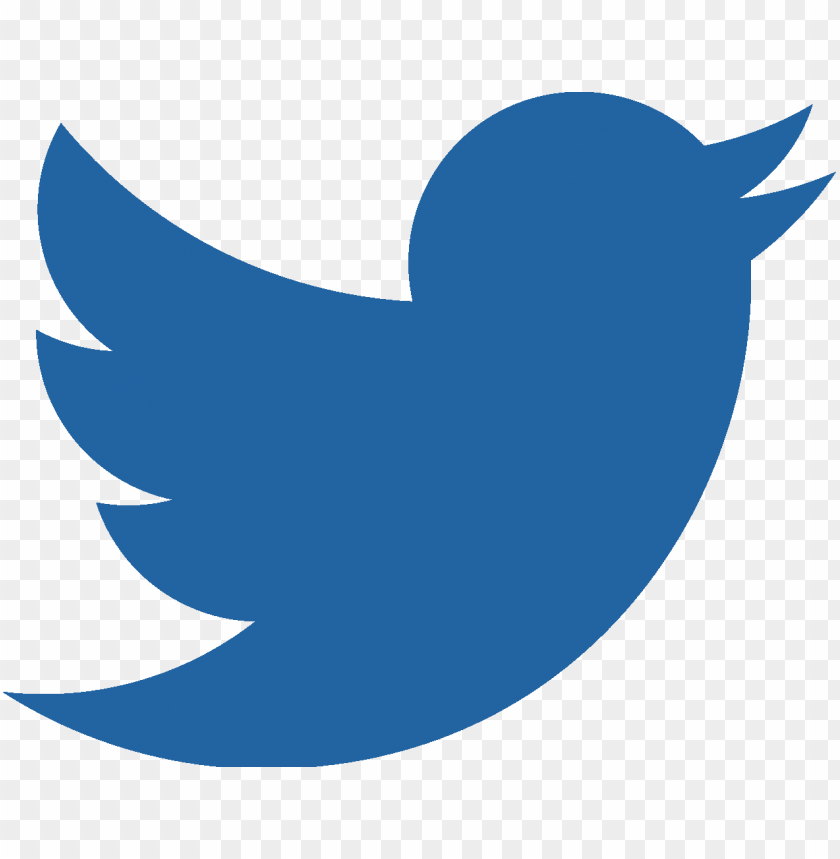Share this?
Tips for YouTube. How to grow it and make money through advertisement
Jun 29, 2022 32 Min Read

Youtube is one of the trendiest way to make money in this century. If you're wondering how to make money on YouTube, look no further than these 7 strategies for monetizing your channel and your creative work.
Okay, ad revenue is the most obvious way to make money on YouTube. But it’s not the only way—or, to be honest, the best way.
(Spoiler: the best way to make money on YouTube is all the ways.)
YouTube is half the internet: that’s 1.9 billion users logging in every month. But at the same time, 500 hours of video are uploaded to the site every minute.
So you already know this article is not going to be about how easy it is to buy a Swiss watch with the ad revenue from your YouTube views. (Though if you have millions of video views, you could probably at least rent one. Wait, don’t.)
1. Join the YouTube Partner Program
The YouTube Partner Program is how regular YouTubers get access to special features on the platform.
You don’t need to be a partner to make money on YouTube (just setting up an AdSense account and getting views is enough to handle that), but being a Partner makes it a lot easier.
YouTube Partners have access to multiple income streams: not just video ads, but YouTube Premium subscription fees, and features that tap your loyal fans’ wallets directly like Super Chat, channel memberships and the merchandise shelf (more on these later.)
Step 1: Start a YouTube channel
Creating a youtube channel is one of the easiest things. Simply download the app and login with your gmail account. On bottom right, clicking you can simply start a channel.
Step 2: Make your channel successful enough that it meets the YouTube Partner Program requirements
To join the program, you need a minimum of 1,000 subscribers and 4,000 watch hours in the previous 12 months.
Here are some ideas for how to get more of those precious YouTube views.
Step 3: Set up an AdSense account
This is simple. Just follow YouTube’s official guide to AdSense accounts.
Step 4: Explore your new monetization features
Each monetization channel has different eligibility requirements. For instance:
- Ad revenue: to earn ad revenue, you must be at least 18 years old, and you must create content that is advertiser-friendly. Basically, the less controversial your videos, the more YouTube advertisers will be comfortable running ads on them, and the more money you make.
- YouTube Premium revenue: if a YouTube Premium member watches your video, you get a portion of their subscription fee. (This one is automatic, which is nice.)
- Channel memberships: in order to sell channel memberships to your subscribers (i.e., your fans opt in to pay you an extra amount), you need to be at least 18 and have more than 30,000 subscribers.
- Merchandise shelf: in order to sell merch from YouTube’s merchandise shelf, you must be at least 18 years old, and have at least 10,000 subscribers.
- Super Chat payments: if you want your fans to have the ability to pay to have their messages highlighted in your live chats during your live streams, you must be at least 18 (and live in a country where the feature is offered).
Step 5: Submit to ongoing reviews
As a YouTube Partner, your channel will be held to a higher standard, according to YouTube. You have to follow not just the YouTube Partner Program policies, but the Community Guidelines. Not to mention staying on the right side of copyright law.
2. Sell your own merch
Maybe you identify as a content creator first, and entrepreneur second. (Just remember that even Drake sells t-shirts.)
Alternately, you’re an entrepreneur first and video creator second, which means you probably already have a product, and you’re designing your YouTube marketing strategy to sell it.
Either way, merchandise is a viable way to earn money from YouTube.
Step 1: Imagine and design your product
Merchandise for your channel is meant to both represent and feed your audience’s connection with you. That means your merch should be unique.
Hawaiian YouTube star Ryan Higa launched his milk-based energy drink Ninja Melk to leverage the popularity of his viral comedy, Ninja Melk. While he also sells t-shirts and other merch from his online shop, Ninja Melk’s appeal is broad enough it has its own website.
Pro tip: You might have more ideas for merch than you can possibly stock. So start by dipping your toes in the water with one or two items. But make sure you engage your audience in the decision-making process. Poll them as to what they want. Or build buzz by offering one-off products related to big subscriber-count milestones.
Step 2: Source and/or build your product
In most cases, you’ll need a manufacturer, supplier or wholesaler to make and deliver your product. Some suppliers will deliver it to you, and some will spare you the headaches of inventory, shipping and returns by handling it themselves.
If you’re not sure where to start, check out Shopify’s how-to on the topic of finding a brick-and-mortar company to make your dream a reality.
Step 3: Create your shop and landing page
You’ll need a separate website to handle purchases. If you want to link it directly from your videos (and you do), refer to YouTube’s list of approved merchandise sites.
Step 4: Enable your YouTube Partner merchandise shelf
YouTube Partners can also use the shelf feature to sell their channel’s merchandise. If you’re eligible, follow YouTube’s instructions to enable it.
Similar posts you may like..
Step 5: Promote your product in your videos
This is where your charm comes in. Wear or use your merch in your videos. Feature viewers who have bought and are using it. (If we were on another platform, we might call this ‘user-generated content,’ or possibly ‘solid gold’).
And don’t forget to add your store’s link to your video descriptions, and include end screens and cards with compelling calls to action.
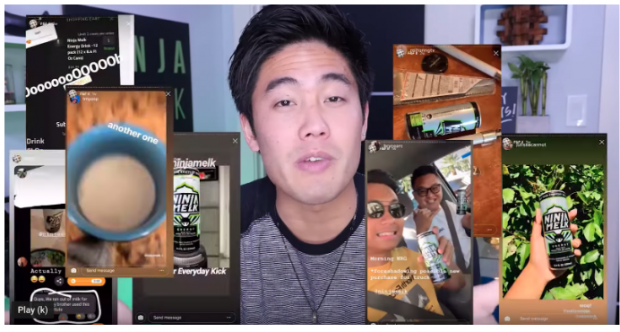
Source: Ryan Higa
Pro tip: Don’t forget to say thank you. Because it’s polite. But also because it’s an excuse to remind people how great and popular your product is, one more time.
3. Create sponsored content
You don’t have to be on Instagram to be an influencer. The advantage of the #sponcon strategy is that you don’t have to give YouTube a cut of your earnings. You negotiate directly with the brand, and they pay you directly. No wonder it’s a popular way for YouTubers to make money.
If you can offer brands a large and/or engaged audience—and your content is relevant to their target market—they probably want to hear from you.
For instance, YouTuber Aaron Marino, a.k.a. Alpha M, is big in the men’s lifestyle space. How big? So big that even his videos that explain his brand partnerships have brand partners.
Step 1: Find a brand to partner with
Quality is important, when it comes to the names you work with. You probably already have a wish list of dream brands. Whether you’re aiming for the stars or building yourself up grassroots-style, make sure you perfect your brand pitch before you send it.
Also consider signing up with an influencer marketing platform. These are intermediary websites that help marketing teams find appropriate influencers to work with. FameBit was one of the first to focus on YouTubers, for instance.
Similar posts you may like..
Step 2: Make a deal
According to this recent study by influencer marketing platform Klear, YouTube videos are, on average, the most expensive type of sponsored content brands can buy from influencers. Basically, YouTube influencers are able to charge more for their videos than they would for Instagram Stories or Facebook posts, because video is just more expensive to produce.
While your rate will vary on your audience’s size, engagement and relevance to your potential partner, know your worth before you sign a contract.
Step 3: Be transparent about your #sponsored #ad
Sponsored content is advertising. That means you need to make sure you’re in step with Google’s Ad policies. The FTC (U.S.) and ASA (U.K.) both have guidelines of which you should be aware, too, if you’re American or British.
Transparency is good for your legal health, but also for your relationship with your audience. YouTube has a visible disclosure feature to help you make sure your audience is aware that you’re advertising to them.
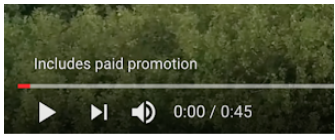
Source: YouTube
4. Become an affiliate partner
If your YouTube audience is loyal and engaged, but not quite there yet headcount-wise, look for companies investing in affiliate marketing.
YouTubers affiliated with businesses encourage their viewers to visit the brand’s online store or specific product pages. They then get a percentage of sales made through their — you guessed it — affiliate links.
In terms of setup and logistics, affiliate partnerships are similar to sponsored content deals, so follow the steps from tip #3 to get started.
5. Get your fans to pay you directly
This strategy for making money on YouTube includes a few different income streams, but they all have one thing in common: you have to make it easy for your fans to show their appreciation with their credit card.
Step 1: Host live chats where people can use Super Chat
In early 2017, YouTube replaced their previous Fan Funding feature with Super Chat. This is a feature that is only available to YouTube Partners while they live stream.
Essentially, your viewers can make their comments more visible—they’re highlighted and pinned for a set amount of time depending on how much they pay—in the live chat stream.
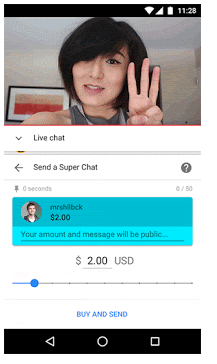
Step 2: Encourage your fans to become channel members
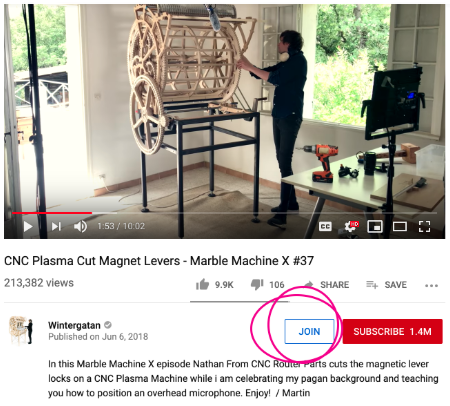
Source: YouTube
YouTube offers the ability to let your viewers pay you to become members of your channel. In exchange, they get custom emoji, badges, and access to members-only exclusives like Live Chats with you.
For instance, Wintergatan is a Swedish band that also makes elaborate marble machines and posts videos about it to their YouTube channel. They regularly thank their channel members in their videos. They also make it clear what the money from memberships supports:
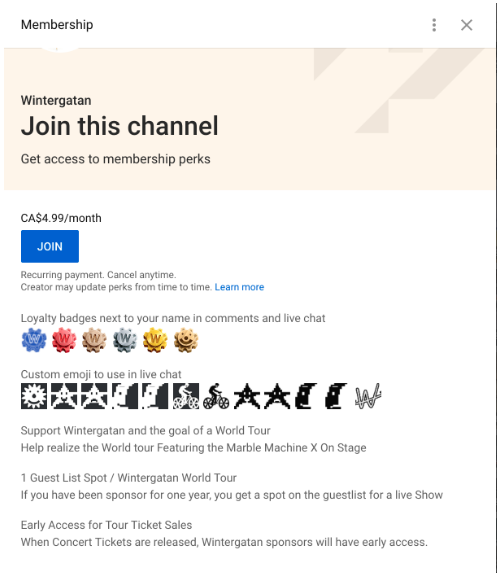
Source: YouTube
You’ll need to build out a promotion strategy to convince people to become members, which may or may not include several tiers of membership. Like Super Chat, this feature is only available to YouTube Partners.
Step 3: Encourage your fans to become YouTube Premium subscribers
This step is the last on our list for this strategy because it benefits your channel only indirectly. That said, when YouTube Premium members watch your channel, you get a cut of their subscription fee. (And so does every other channel they watch.)
6. Use crowdfunding
Soliciting donations online is now commonplace. Whether you’re looking to build ongoing revenue from a pool of small monthly donations, or looking to fund a personal, channel-related project, crowdfunding is how many YouTubers make money.
Step 1: Set up a crowdfunding account
YouTube has a list of approved crowdfunding sites to choose from.
For recurring funding Patreon is a top choice. Meanwhile, sites like GoFundMe or Kickstarter are best for one-off campaigns to get a new mic, or new laptop, or new … spleen.
Even household names like Walk Off the Earth or Veronica Mars (ok, she’s a fictional character) have used Patreon to fund their projects, be they music videos or feature-length films.
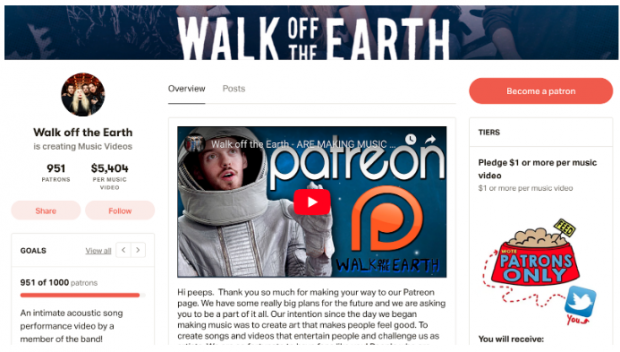
Source: Walk Off the Earth
Step 2: Promote your campaign in your videos
Detail your specific goals so that people know exactly what they can expect when you’ve succeeded.
Also, offer enticing perks that stack as your fans choose how much they want to donate.
For more information and inspiration, check out this detailed guide to crowdfunding strategies.
Step 3: Go beyond YouTube
A successful campaign is a multi-platform affair. We have some advice on how to promote your YouTube channel (and by extension, your crowdfunding campaign) everywhere else.
7. License your content to the media
When a video goes viral, every news outlet wants to get their hands on a copy in order to replay it for their audience. Fortunately, established media companies are well aware that they need to pay for what they use. And voila, you’ve got yourself another way to make money on YouTube.
As a content creator, licensing your most successful work to the media can be as simple as making sure you’re easy to find.
Step 1: Keep your contact details updated on your About page
You never know when lightning will strike. Even if you don’t have a business manager, set up a generic email account that you can point to for business inquiries.
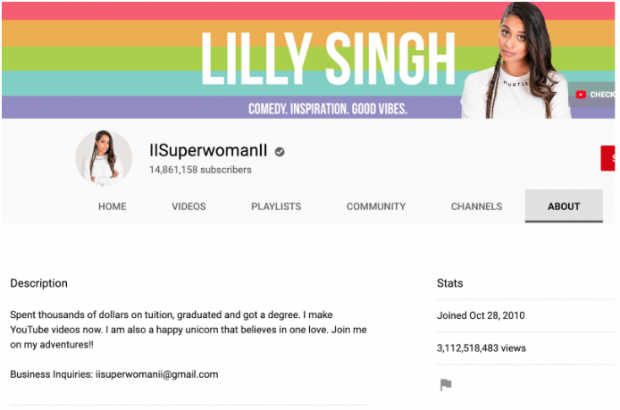
Source: Lilly Singh
Step 2: Sign up to a video rights marketplace
Jukin Media is a great place to start. Even if you don’t have a viral video like the Chewbacca mask lady (see below), media outlets often need timely footage to round out their reporting.
For instance, Jukin has an entire catalogue of ‘newsworthy’ videos that you can contribute to, if you happen to have exclusive footage of a major natural disaster, plane crash, or plague of locusts.
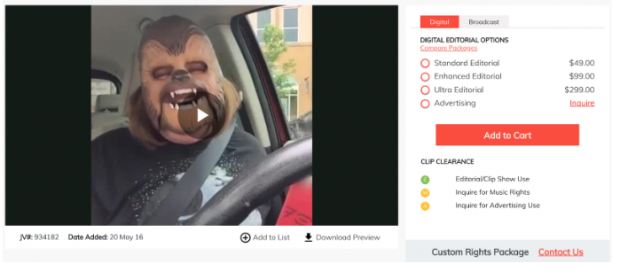
Source: Jukin Media
How much money can you make on YouTube?
Sadly, this age-old question has one infuriating answer: it depends.
The sky is the limit, as 9-year old YouTuber and multi-millionaire Ryan Kaji’s story proves. But getting into 7-digit territory takes a lot of time, consistent work and luck.
YouTube revenue relies heavily on AdSense. In simple terms, YouTubers get paid for each ad view on their channel. But rates vary across geographies, demographics, and even industries (software ads may have a higher CPM than, for example, clothing ads).
On average, YouTubers make between $3 and $5 per 1,000 video views through AdSense. If your channel is reaching a lot of people, this can stack up to a pretty paycheck. It’s not uncommon for big creators to cash out upwards of $200,000 each month from AdSense alone.
But even if your channel is trending and AdSense revenue is filling up your bank account, remember that YouTube fame depends on many factors, some (or most) of which are out of your control — the YouTube algorithm can change, as can your audience’s tastes and needs.
To make sure that the money you make on YouTube turns into a healthy and consistent income, follow our 7 tips and branch out. Merch, branded deals and crowdfunding can make you money even if, for whatever reason, your AdSense paychecks go down.
Making money with youtube this year
YouTube stars are today’s self-made celebrities—people who have earned an audience by creating video content geared toward teaching, entertaining, reviewing, and being awesome on the web.
Making money on YouTube might not be your reason for starting a channel, but the opportunities to earn are a pleasant surprise once you realize how many of them there are. Luckily, there are some creative ways to make money on YouTube.
Your audience might unlock your YouTube channel’s earning potential, as is often the case with Instagram influencers or bloggers, but it’s the creation of multiple revenue streams, through side hustles or businesses, that helps you make money.
1. Join the YouTube Partner Program
The first revenue stream you’ll likely explore is ads. Whether you want to earn money on YouTube without creating videos or as a content creator, joining the YouTube Partner Program and setting up monetization is a vital step.
You’ll have to agree to follow all of YouTube’s monetization policies and live in a country or region where the YouTube Partner Program is available. Then you can apply for monetization once you’ve hit 1,000 subscribers and 4,000 watch hours over the past year.
Here’s how to enable monetization on YouTube:
- Sign in to the YouTube account you want to monetize.
- Click the icon for your account in the top right corner.
- Click YouTube Studio.
- In the left menu, select Other Features > Monetization.
- Read and agree to the YouTuber Partner Program terms and eligibility requirements.
- Create a new Google AdSense account or connect an existing one to your channel. (You need an AdSense account to get paid.)
- Set your monetization preferences.
Once that’s done, head back to the dashboard and click the Analytics tab on the left side. From there, you’ll need to choose Revenue from the tabs at the top, then scroll down to the chart Monthly Estimated Revenue to get an idea of your predicted YouTube revenue.
What is YouTube Premium?
YouTube Premium is a paid membership program that lets fans watch and support their favorite content creators without ads. For creators, not much changes, as they will get paid for content consumed by non-members on YouTube, along with content on YouTube Premium.
Creators are paid for YouTube Premium based on how much members watch their content. Consider revenue earned from YouTube Premium subscribers as a secondary revenue stream in addition to what you’re already earning through ads.
While it’s easy to set up, earning money through advertising as a YouTube Partner is far from the most lucrative revenue stream you can create for yourself.
Why you should look beyond ads for revenue
YouTube recently received a lot of backlash due to its decision to be more transparent about advertising on the platform and what qualifies as “advertiser friendly” content.
Essentially, many YouTube creators feared that, due to the nature of their content, they would lose out on the advertising revenue that helps support their channel.
According to YouTube, your content could get excluded from ad revenue if it includes:
- Sexually suggestive content, including partial nudity and sexual humor
- Violence, including displays of serious injury and events related to violent extremism
- Inappropriate language, including harassment, profanity, and vulgar language
- Promotion of drugs and regulated substances, including selling, use, and abuse of such items
- Controversial or sensitive subjects and events, including subjects related to war, political conflicts, natural disasters, and tragedies, even if graphic imagery is not shown
But the reality is that YouTube has been demonetizing content that it doesn’t deem advertiser friendly since 2012 via an automated process, without warning and without the content creator’s knowledge.
Now, the situation is actually better, as creators are notified when their content is flagged and can contest any time they feel a video was mistakenly excluded from YouTube’s advertising network.
Advertising might be a common means of generating passive income for creators, but the trade-off is that YouTube’s parent company, Google, gets to keep around a 45% share of ad revenue.
In short, YouTubers should explore other revenue streams to sustain their creative hobby. Below, we’ll share how to earn money from YouTube without AdSense.
2. Sell products or merchandise
There are plenty of products to sell that can help you make money through your YouTube channel. Selling merch—t-shirts, coffee mugs, tote bags, snapbacks, you name it—has a benefit beyond revenue.
Merchandise increases your exposure by putting your online brand and personality out into the offline world and deepens the relationship between you and your fans as they literally “buy” into what you’re doing. Creators like Roman Atwood sell a variety of merchandise in his store under the Smile More brand.
Alternatively, you can partner with an existing merchandising network for creators, such as DFTBA (Don’t Forget to Be Awesome). However, you’ll be competing with other YouTubers and have less control over adding products, offering discounts, integrating your content, and all the advantages that come with owning your own ecommerce site.
You can even go a step further by manufacturing and selling your own unique products and powering your business through your YouTube channel, like Luxy Hair did to sell its hair extensions with hair-related how-to video tutorials.
As a YouTuber who’s already earned an audience, you’ll have two advantages from the start that other store owners would be jealous of:
- A content engine that consistently drives traffic to your store
- Your audience’s trust, which you’ve earned by regularly serving them your own brand of content for free
3. Crowdfund your next creative project
When money is all that stands between an idea and its execution, crowdfunding is a good way to make it happen.
Whether you need help buying better equipment, hiring actors, or covering other production costs, you can call upon your own audience and the crowdfunding community to pitch in, if your idea is compelling enough.
Many successful crowdfunded creative projects tend to offer a sneak peak or “trailer” that gets people excited, so consider shooting a video explaining your project or offering a taste of what it’ll be like, such as this popular Kickstarter for Kung Fury, a short film paying homage to ’80s action movies.

Popular crowdfunding sites with a proven track record of campaigns from YouTubers include:
- Kickstarter. One of the most well-known crowdfunding sites, great for funding cool products and creative projects. Be sure to set an attainable funding goal because you’ll only secure it if you actually meet the goal you set.
- Indiegogo. A Kickstarter alternative that offers more flexible funding options.
4. Let your audience support you through “fan funding”
Similar to crowdfunding a project, you can also set up “fan funding” streams to source donations from your audience.
As a creator, you’re contributing your voice to the internet without forcing your audience to pay for admission. So, if you’re offering good content, your audience might be inclined to support you on an ongoing basis.
Many fan-funding platforms offer creators another place for people to discover their content and a way to engage their most loyal audience and reward them for their support.

Wait But Why creates more long-form written content than YouTube videos but is a great example of receiving support from the Patreon community.
If you choose the crowdfunding route, be sure to follow a couple of best practices. First, create transparency around how the money will be spent. This will get your fanbase invested in your story or mission, and they will literally buy into the value of your content.
Second, offer enticing rewards for better pledges. The more you can make donors feel like they’re getting something exclusive for being a loyal fan, the more likely you are to get donations and higher pledges.
Some popular fan funding options include:
- YouTube’s Super Chat. Super Chat is a feature used when doing live streams on YouTube. It lets you create a tipping jar for your viewers to donate whenever and however much they feel like contributing. You’ll need to set up your YouTube account for advertising, as outlined above.
- Channel memberships. Channel memberships let viewers support your channel through monthly payments in exchange for members-only perks. Similar to Super Chat, you must be a part of YouTube’s Partner Program to access this feature.
- Patreon. The membership platform that makes it easy for creators to get paid. Fans can subscribe to their favorite creators for as little as a dollar a month and receive exclusive rewards.
- Tipeee. This platform lets you get a combination of both one-off and recurring donations.
- Buy Me A Coffee. Buy Me A Coffee lets creators and artists accept donations and membership fees from their fans. It’s referred to as the “#1 Patreon Alternative,” with over 300,000 creators. The differences are it’s easier to accept payments with Buy Me A Coffee, there’s a flat 5% fee for all features (versus up to 12% for Patreon), and payouts are instant.
5. License your content to the media
If you happen to create a viral video with mass appeal—say, a funny clip featuring your dog—you can license your content in exchange for money.
TV news outlets, morning shows, online news sites, and other creators might reach out about rights to use your videos if they happen to go viral.
You can also list your videos in a marketplace, such as Trusted Media Brands, where your content will be easier for the right people to find and purchase.

When this video of a woman wearing a Chewbacca mask went viral, tons of media outlets wanted in.
6. Work with brands as an influencer
Brands are investing more and more in influencer marketing and sponsorships, spending their typically large advertising budgets on influencers who’ve already won the loyalty of their audiences.
This creates a massive opportunity for you as a creator if you can negotiate the right deals.
Brendan Gahan, a YouTube marketing expert and influencer, recommends establishing your baseline flat fee by looking at the number of views your videos typically get and multiplying it by $0.05 to $0.15 per view (which is around what many brands are willing to pay for views via YouTube ads).
According to data from WebFX, the potential prices for influencer marketing on YouTube are:
- $200 per video for a YouTuber with 10,000 subscribers
- $2,000 per video for a YouTuber with 100,000 subscribers
- $20,000 per video for a YouTuber with 1,000,000 subscribers
Depending on your leverage—your audience demographics, content quality, and how unique and profitable your niche is—you might be able to negotiate a better deal if the brand is a good fit.
The key when partnering on brand-sponsored content is to be transparent about it, not endorsing anything you don’t actually like or believe in, and being upfront with your audience about why you’re doing it.
Here are just a handful of the many influencer marketplaces you can add your channel to and get discovered by brands both big and small:
- Crowdtap. Complete small content creation “tasks” in exchange for money and other rewards. There’s no restriction on how many followers you need to join.
- Upfluence. A full-scale influencer platform with a database over 3 million influencers. Clients can search through Upfluence to find creators by keyword and contact them to form a partnership.
Some influencer marketplaces offer you free products, while others are known for having big brands who are willing to pay more. Capitalize on the opportunities that best suit your needs, but list yourself in as many places as you can to ensure maximum visibility for your channel.
7. Become an affiliate marketer
Affiliate marketing refers to earning a commission by promoting a product or service made by another brand. You can become an affiliate marketer for brands and include product placements, endorsements, or other types of content. However, you must disclose the partnerships to viewers in your videos.
This works especially well if you review products as part of your YouTube channel. Since there’s no risk involved on the brand’s end (they only pay when they make sales), there's usually a low bar to getting started.
Popular affiliate programs include ClickBank (1% to 75% commission, depending on what the vendor sets) and Amazon’s Affiliate network ( up to 10% per sale). You can also reach out to brands in your niche that are running their own affiliate programs, which isn’t uncommon in the ecommerce space.

Selling branded swag is easier than it might seem at first. You can order affordable designs tailored for specific products, like t-shirts, using freelance sites such as Fiverr.
And when it comes to handling orders, you can integrate your store with services such as DSers or one of the many print-on-demand providers that take care of shipping, fulfillment, and customer support, letting you reap all of the benefits of a print-on-demand business that requires less effort on your part.
How many views do you need on YouTube to make money?
The average YouTube channel can receive around $18 per 1,000 ad views, which equals around $3 to $5 per video view, according to data from Influencer Marketing Hub.
The number of views you get doesn’t correlate to revenue earned. If your video gets thousands of views but no one watches or clicks the ad, you won’t make any money. This is because of YouTube’s criteria for billing advertisers: a viewer must click an ad or watch the video ad in full (10, 15, or 30 seconds) for you to get paid.
How to get paid on YouTube
- Publish ads on your channel
- Offer channel subscriptions
- Offer channel memberships
- Sign up for affiliate marketing
To start earning money directly through YouTube, you must have a least 1,000 subscribers and 4,000 watch hours in the past year. Once you reach that, you can apply to YouTube’s Partner Program and monetize your channel.
One area where you can make money as a beginner with a small number of subscribers is affiliate marketing. Niches like food reviews, product openings, and top [X] lists are popular topics for YouTubers. You can earn money when they purchase affiliate products from your video, versus an ad click or video view.
How much money do YouTubers make per year?
The top 5 YouTubers as of January 2021 have tens of millions of followers each. Accounts include MrBeast, Jake Paul, Markiplier, Rhett and Link, and Unspeakable. These YouTubers earn upward of $28.5 million per year through their channels. While what they earn is enormous, smaller accounts can still earn a living on YouTube.
Take Justine Leconte’s YouTube channel, for example. She has 913,000 subscribers and 91 million video views on her channel, which helps people dress better and understand fashion. Just off ad revenue, her total estimated earnings are around $259,304, earning $979 per video, on average, according to Influencer Marketing Hub’s YouTube Money Calculator.

Based on these estimated numbers, Justine could earn a living off her YouTube channel by posting one or two videos per week. It’s important to note that these are just estimates. Justine could be earning more or less than the numbers above, depending on the YouTube monetization strategies she uses for her business.
How do YouTubers get paid?
Data from Forbes shows that the top YouTube earners make 50% of their annual income from ads. You can set up an AdSense account and enable monetization once you create a YouTube channel. You only get paid once you reach $100 in your AdSense account.
YouTube channels can be monetized even if they don’t have millions of subscribers. Your earning potential isn’t determined solely by the number of subscribers and views you have, but also by the level of engagement you generate, the niche you cater to, and the revenue channels you explore. That’s not to say subscriber count doesn’t matter—check out our tips to get more subscribers on YouTube.
Second, this list of top 10 earners might give you the impression that the millions of dollars made comes directly from YouTube. In fact, each of these channels has its own line of merchandise. These channels found and built their audiences first, before launching their own merchandise. If making money on YouTube is in your marketing plan, the first step is the same for everybody: have a clear understanding of your target audience.
Tips for selling on YouTube
Many of the above strategies for monetizing involve promoting products or campaigns (e.g., crowdfunding a video series). But you’ll want to make sure your promotions don’t sabotage the integrity of your high-quality content.
“Selling out” is a real concern for a lot of creators. But if you never ask, you’ll never get. There are a number of “placements” you can choose from for promoting products or campaigns.
Understand your audience on YouTube
Building your own audience puts you in a great position to monetize content in a variety of ways. But you’ll only be able to take full advantage of the opportunities you have if you understand the makeup of your audience.
For many YouTubers looking to monetize, the more niche your channel, the better position you’ll be in to work with brands looking to target specific audiences (more on that later).
You’ll want to pay close attention to:
- The gender of your audience, to see if it skews toward one particular group
- The age range most of your audience falls into
- The geographic location—countries or cities—where your videos are being watched
- Your audience’s overall engagement, or “watch time”
With this demographic information at hand, you’ll have a better understanding of your own audience and be able to work better with brands. All demographic insight can be pulled from your YouTube analytics, but to compare your own channel against others, try a tool like Social Blade.
Record a call to action in your videos
“If you liked this video, then hit the Like button and subscribe.”
Many YouTubers include a call to action along those lines at the end of their videos to grow their viewership. By suggesting the intended action you want them to take, your audience is more likely to take it.
You can adapt this approach to direct your audience’s attention to a revenue-generating opportunity.
Add well-timed YouTube cards to your videos
Whether it’s part of your deal with a brand or you’re promoting your own products, YouTube Cards offer an eye-catching way to get the attention of engaged viewers.
You can set them to pop up at just the right moment, when they’re most relevant and least distracting, to increase their impact.

Add links in your video descriptions
You can funnel viewers to your store, Patreon page, Kickstarter campaign, or other revenue-focused part of your online presence by adding links to your video descriptions.
If you’re a video creator who wants to focus on generating revenue as an affiliate marketer, look at Unbox Therapy. Unbox Therapy specializes in product reviews, and it uses affiliate links in its video descriptions to make money via YouTube audiences.
If you’re creating videos about your own products and you own or manage a Shopify store, you can incentivize new customers to buy your products with “buy X get Y” promotions or discounts.
Promote your offer on other platforms
Just because your content is hosted on YouTube doesn’t mean you shouldn’t be taking advantage of all the other distribution channels out there.
Spread the word about new campaigns or discounts on Twitter, Facebook, and any other profiles you own.
The more places your message lives, the greater the chance it’ll be seen. So it’s always a good idea to grow your following beyond YouTube with social media marketing.
The rise of the “YouTubepreneur”
What compels most creators to create is rarely money. It’s the thought of making something for the world to enjoy. Many famous YouTubers started out with humble beginnings, like PewDiePie, who created content on commentaries of him playing video games.
But ironically, that puts them in a great position to actually make money in a content-obsessed world.
While the hard part for many businesses is getting and keeping their audience’s attention, YouTubers have already figured that bit out.
All that’s left is to get creative and channel the entrepreneurial drive to explore ideas with how you choose to monetize your audience and your passion.
How to make money with youtube summary
Making money on YouTube FAQ
How many YouTube views does it take to make $1,000?
Based on industry averages, you’ll need about 500,000 views to earn $1,000 from ads. The cost per thousand (CPM) works out to be $2 per 1,000 impressions.
Do you get paid for uploading videos on YouTube?
Content creators aren’t paid by YouTube for the videos they upload. Neither are videos monetized by default. For you to start making money on YouTube, you have to enable monetization in your YouTube account settings. From there, you have options to join the YouTube Partner Program or have your videos listed on YouTube Premium.
How do YouTubers make money on YouTube?
- Join YouTube's Partner Program
- Sell products or merchandise
- Crowdfunding
- Fan funding
- License content to media
- Work with brands as an influencer
- Become an affiliate marketer
How can you make money on YouTube without making videos?
The only way to make money from YouTube without producing videos is to re-use other creators’ content. YouTube has a library of videos that fall under the Creative Commons license. This license lets you publish other people’s content and earn money from it. If you find a video with the CC-BY license, you can use and tailor it to your liking.

